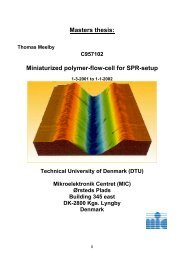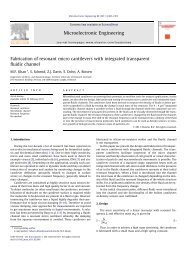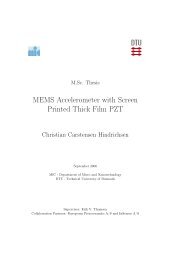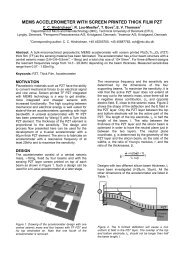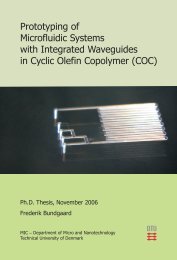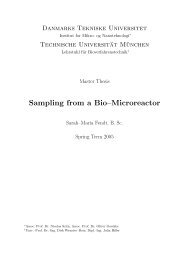Development of a Oxygen Sensor for Marine ... - DTU Nanotech
Development of a Oxygen Sensor for Marine ... - DTU Nanotech
Development of a Oxygen Sensor for Marine ... - DTU Nanotech
Create successful ePaper yourself
Turn your PDF publications into a flip-book with our unique Google optimized e-Paper software.
58 CHAPTER 7. EVALUATION OF RESULTS AND MEASUREMENTS<br />
process step, in case problems with the rest <strong>of</strong> the process should arise.<br />
There was one small problem with the Pt, the exposure time in the photolithography<br />
was originally set to 7 seconds instead <strong>of</strong> 4. As a result this,<br />
both the working array and the temperature sensor had huge gaps, or were<br />
missing entire as seen on Figure 7.1.<br />
However once the exposure time was lowered to 4, the problem was solved,<br />
and the fine structure and small dots <strong>of</strong> Pt was clearly evident, as seen on<br />
Figure 7.2.<br />
Figure 7.2: Pt are no longer missing and both the dots in the working and<br />
the lines in the temperature sensor looks fine.<br />
Beyond this however there was no real problem in fabricating the chip,<br />
except <strong>for</strong> the problems already mentioned, also while the recipe <strong>for</strong> the<br />
titanium silicide was new, it <strong>for</strong>med successfully.<br />
7.2 Temperature <strong>Sensor</strong><br />
The temperature sensor was tested to see if it had the required linear dependency,<br />
and to see if the TCR (Temperature Coefficient <strong>of</strong> Resistance) varied<br />
from the standard and if so, how much it did. This is done in order to know<br />
how much that needs to be compensated, since there is a titanium strip beneath<br />
the platinum, and the gold contacts can also be expected to change it<br />
a bit.<br />
The experiment was done using 2 multimeter’s, a probestation, and a<br />
heating plate. The chip measured on was placed in the probestation, and<br />
the 2 multimeter’s was connected, one measuring the temperature <strong>of</strong> the chip,<br />
and the other measuring the resistance through the temperature sensor. The<br />
heating plate was then used to raise the temperature to around 50 o C, after<br />
which it was cooled down. Measurements was made both while heating and<br />
cooling.



